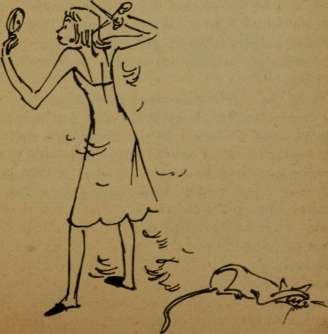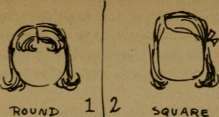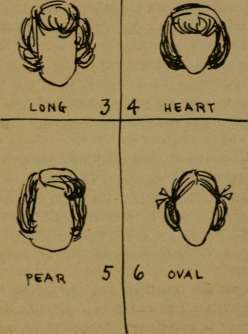After the shampoo comes the setting. Indeed, for some teens setting comes every night of the week, shampoo or no, and for those who learn to do a first-rate job, the rewards will be great. Ultimately, the way your hair looks after it is taken down from the curling apparatus depends upon how skillfully it has been put up.
Setting hair well does not take professional knowledge, but it does take a little time. However, the more you do it, the more adept you become and the less time the process involves. Some girls can put up their hair (even those with short-cropped hair that involves many, many pin curls) in the time it takes most people to brush their teeth.
There is one general rule that makes hair setting a success, whether your hair be long or short: it is not advisable to set your hair while it is wet. Wet hair that is allowed to dry during the curling process will emerge kinky and sausage-tight. A better method is to set your hair when it is dry and then to wrap your head turban-fashion, with a towel that has been wrung out in very hot water. The steam from the towel will penetrate the rolled-up curls and dampen each slightly. This dampness will be sufficient to give each curl the required amount of moisture to make it set, but not so much that the curl is drowned.
Let the towel turban remain on your head for five minutes. Then remove it, and put a net around your head to hold the curls in place. Allow your hair about fifteen minutes' time to dry out completely. When you unfurl your curls, lo and behold, you will discover that your hair is soft and delicate, not frizzed like a South Sea Islander's. This curl, by the way, will withstand any amount of bnishing. Don't be afraid to attack your hair after it has been set. Curl will not come out if it has been properly set and if the hair is truly dry.
While this rule for dry-setting holds for any length of hair, it is true that different lengths of hair do demand slightly different curling techniques. Short hair cannot be set in the same way as long hair. If you change your hair length, then you must also change your setting technique.
If your hair is long (to your shoulders), the best way to set it is with rag curlers. These, unlike metal ones, will not split the ends, and they are lots more comfortable to sleep on. To give the rag, which by its very nature is rather limp, additional firmness, first fold it lengthwise over a twice folded facial tissue. Then place the rag lengthwise across the end of the strand of hair to be curled and roll up the hair in it. Hold it in place by tying the two ends of the rag together. For most teens, two rags at each side and two in the back are sufficient.
If your hair is short, on the other hand, rag curlers will not do the trick. Short hair needs to be curled in very small sections, each section no more than a wisp or two. Roll each wisp over your finger and secure it with a metal clip or hairpin. Make certain that you put in enough pins to hold each curl in position. By putting a hair net over the whole business, you can reduce the chances of a curl slipping out of place.
When you have become really expert at putting up your own hair, you may want to try a home permanent. I would not advise you to try one if you are all thumbs with your tresses, because it is too easy to bungle the job. A home permanent is based on one's ability to handle hair with ease. But many teens with the practice and experience of doing their own hair day after day should have all the skill required.
If you decide to try a home permanent, read all the directions carefully and follow each to the letter. Do not try any short cuts of your own. Best of all, give yourself a home permanent over a weekend, when you have time to take pains.

About the only thing a teen cannot do well by herself is to cut her own hair. Cutting and shaping takes professional know-how. There is a great deal more to it than hacking with scissors or a razor. Unless you have an uncanny knowledge of what you are doing with your hands at the back of your head when you can't see them you had better leave the cutting to a professional.
Basic to any good-looking coiffure is a well cut, well shaped head of hair. It is almost impossible to set hair well if it is unevenly trimmed or too thick and bushy. With the pennies you save by doing your own shampoos and settings, you can afford to have your hair cut at a beauty parlor. If your hair is short, you need to have it shaped at least once a month. If your hair is long, you can wait longer, but not so long that it gets out of kilter and straggly about the edges.
Now that you have patiently borne with me while I discussed all the things you need to know in order to keep your hair healthy and in good condition, you will want to ask, "But how should I wear my hair?" Unfortunately, that is a question for which I have no general rule. There is no one all-becoming hair style. Every girl needs to wear her hair the way that suits her best. By experiment she usually finds her own best style.
Still there are a few guideposts that beauticians and hair stylists have devised for choosing the most flattering hair style. These guideposts are based on the assumption that the oval face is the most beautiful, and in consequence the hair should be so arranged as to make every face seem to be oval.
Aside from the admired classic oval face, there are five other types of faces. They are:
1. The round.
2. The square.
3. The long and narrow.
4. The heart (wide at forehead, narrow at chin).
5. The pear (narrow at forehead, wide at jaw).
HAIR


The teen with the round face needs to give an illusion of length. Her hair then should be styled with interest at the top. The sides should be kept smooth and her hair brushed away from her face. The simpler the hair style, the better. Too sweet curls look babyish.
The teen with the square face needs to soften her somewhat severe and angular lines. A short bang or flip at the fore-head is a flattering touch. Hair that is short and brushed away from the temples and curled behind the eartips looks well. She should never have her hair cut so that it just comes to the angle of the jaw. Long hair rolled under in a page-boy and kept behind the ears, or short hair smoothed flat at the sides should suit her best.
The teen with the long and narrow face needs to give herself more width. She should always have her hair softly waved, as severely cut straight hair will tend to emphasize her long face. In-between lengths are the best, and a bang over the forehead will shorten the distance between hairline and jaw.
The teen with the heart-shaped face needs to give more width to her jaw. She should try to wear her hair in such a way that fullness fills out her jawlirie with the hair covering the ears. Again a soft bang at the forehead will help to mask the width.
The teen with the pear-shaped face needs to make more of her forehead, less of her jaw. She can give width on top by giving herself a flip of hair, like half a bang, or dipping the hair gently at one side. She should keep the interest to the top and have her hair at the bottom short enough to curl just slightly over the edges of the jaw, masking some of the width.
The teen with the oval face may do as she pleases. Long, short, or in-between, she can go the way she wants. Because she has so many possibilities, she should try to keep herself in the forefront of fashion, trying out each new hair style as it comes along.
Teens with other than oval faces, however, need not feel that they cannot change with the fashions. Because the rules say add width, or give an illusion of length, there is no reason to stick to them too rigidly. Many girls have flaunted all the rules with great success. However, if you do it, make sure you are doing it for the best.